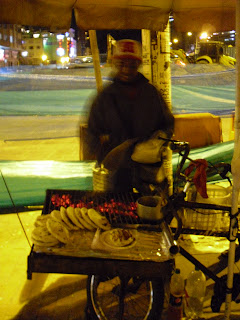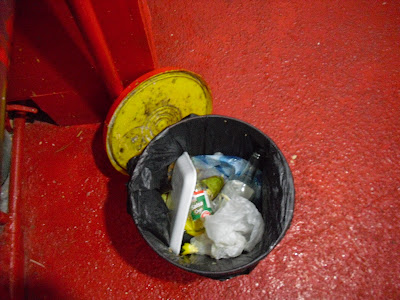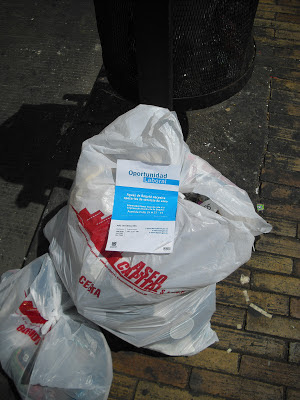Despite the irrational and subsequently unfounded fear in some quarters that the world would end on 21 December just gone (remember all the hullabaloo?) because of a Mayan prediction, we’re still here, same as always, more or less.
Of course, ‘officially’ the Mayans weren’t predicting the end of the world at all; it was just the end of their twelfth calendar and the beginning of number thirteen.
In any case, a large number of us use the Gregorian calendar these days, which sees us entering a new year. So, in keeping with our exceptional originality here, we’re going to look back at some of the things that we’ve derived most pleasure from in 2012.
Well, at least we’re being outwardly positive for a change. And as you’ll see – in no particular order and far from exhaustive, by the way – there have been plenty of things that brought a smile to our face in the past year:
 | ||||
| The Panama Canal. |
Seeing more of the world
Considering it’s travelling that has us in Colombia in the first place, we’ll start off on this one. 2012 saw us add four more countries to our imaginary visited list – but far from done list (don’t get us started on that one. A very irritating turn of phrase used by far too many backpackers).Firstly there were the ‘delights’ of Venezuela – it’s true, time is a great healer (for what we thought of the country at the time, see http://bit.ly/OLR2Ev).*
Then there was the very beautiful – if a little bit pricey for our modest and declining earnings – Barbados. That necessary trip to see a very good friend get married included a brief stop in Trinidad, enough, though, to take in a bit of Port-of-Spain, with its almost unbearable heat and quite friendly locals from what we encountered.
Then there was the very beautiful – if a little bit pricey for our modest and declining earnings – Barbados. That necessary trip to see a very good friend get married included a brief stop in Trinidad, enough, though, to take in a bit of Port-of-Spain, with its almost unbearable heat and quite friendly locals from what we encountered.
We finished off our brief little Caribbean adventure with a longer return to Panama – we had actually walked into that country earlier in the year from bordering Capurganá in Colombia. This time around we actually got to stay a few nights; and it was well worth it.
On top of all this, we did take in more of the wonderful country that is Colombia itself, but there is still plenty more we want to see here. Time to get moving again pretty soon we reckon.
On top of all this, we did take in more of the wonderful country that is Colombia itself, but there is still plenty more we want to see here. Time to get moving again pretty soon we reckon.
‘La Grande’ arrives
This may shock some of you, but we like a beer every now and again – the bigger (and cheaper) the better.For some unknown reason, though, since we first visited Colombia in 2009, all you could purchase in the majority of bars/tiendas were the small 330ml bottles. In most of the other South American countries 750 ml or litre bottles are the norm.
Thankfully this year saw Colombia get up to standard with both Aguila and Poker introducing the 750 ml bottles. Linked to this is the ‘discovery’ of cheap and cheerful tiendas with appreciative staff (are you listening Doña Ceci et al?) to consume said bottles.
Thankfully this year saw Colombia get up to standard with both Aguila and Poker introducing the 750 ml bottles. Linked to this is the ‘discovery’ of cheap and cheerful tiendas with appreciative staff (are you listening Doña Ceci et al?) to consume said bottles.
We thought we were doing well with $3,000 COP a bottle (roughly €1.20), but that’s been trumped by a lovely little place in Bogotá’s Belén district for $2,500 COP a bottle. It’s the ‘little big’ things in life that count.
For a related article, which also details our perhaps dangerously addictive liking for value-for-money coffee and biscuits, see “Bogotá’s simple pleasures” http://bit.ly/Uzc3lk.
 | ||
| Game-changer. |
A star is born
OK, not quite. But we did get a glimpse inside the telenovela (that’s utterly cheesy Latino soap operas) world with our work as an extra from time to time. Heck, we’re even due to appear ‘prominently’ in some made-for-TV US movie, Left to Die, which is already out apparently.Although, we can’t help but think that we’ve already had our, precisely speaking, ’30 seconds’ of fame from this type of work. That came during our appearance in ‘Colombia Tiene Talento’ (Colombia’s Got Talent), where we had to wave a flag all dressed in white for one of the acts.
Such was the 'quality' of our performance it made waves across the globe, with The Irish Daily Star giving us a spread in its pages.
Alas, we failed to get the expected flag-bearer gig at the Olympics for either Team Ireland or Team Colombia. There’s always Rio in 2016... For more on this see Giving just a little bit ‘extra’ http://bit.ly/NrbPc3 and for our flag-waving extraordinaire see, from 2’ 30’’ http://bit.ly/TZsutM.
 |
| 'Flagtastic' - indeed. |
Teaching English
There are times when we wouldn’t feel like putting this down as a positive, but on the whole we’ve found it quite enjoyable.It’s helped us meet some very interesting, decent people, both in terms of the companies we’ve worked for (firstly Instituto Nordico, now BSR Idiomas and indeed our private classes) and the students we’ve taught.
We’ve even managed to make a little bit of money out of the whole gig – just a little mind you. For a more thorough look at this world, see our earlier piece, The ‘Money’ Tongue http://bit.ly/V8ELH4.
Best Man for an old-time friend
As mentioned above, the reason we went to Barbados. It was a privilege and an honour to be at the side of one of our oldest (in length of time we've been mates that is, not age, lest we insult anyone) and best friends.Second time to be a best man, the chances of our own tying of the knot are a long, long way off, however. We’re happy to watch from the sidelines at this moment in time; horses for courses and all that.
 |
| Picturesque. |
Street arepas
OK, we knew about these round corn-based delights before the start of 2012, but it was in this year that we really got to enjoy them; simple yet wonderful pleasures.The perfect hunger-buster on a chilly Bogotá evening, our preference has been the ‘carne con queso’ (that’s meat with cheese with a bit of BBQ sauce to boot) for a very agreeable $2,200 COP (roughly €1).
For those of you who know the Colombian capital, our favourite place to consume these is from the vendor that operates outside the Colombo-Americano, Calle 19 with Carrera 3. We’ve missed them over the Christmas break – come back soon.
So that's some of our highlights from 2012. All that's left for us to say for now is, Happy New Year to all; onwards and upwards in 2013.
________________________
*Please note, for an updated, more positive piece on Venezuela, see (for starters) see Venezuela: A necessary reappraisal.
 | |
| Quality grub. |
________________________
*Please note, for an updated, more positive piece on Venezuela, see (for starters) see Venezuela: A necessary reappraisal.











